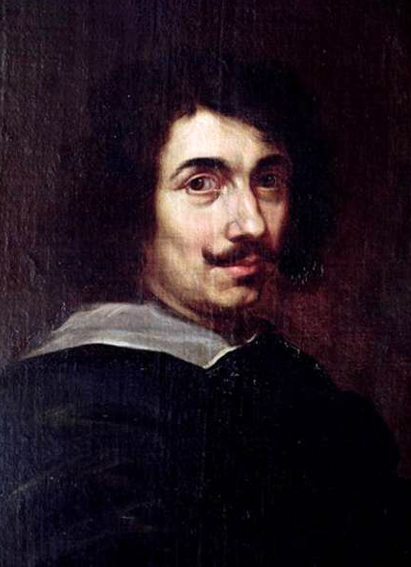
1600 - 1682

Claude Lorrain, also known as Claudee Gelle, French artist best known for, and one of the greatest masters of, ideal-landscape painting, an art form that seeks to present a view of nature more beautiful and harmonious than nature itself. The quality of that beauty is governed by classical concepts, and the landscape often contains classical ruins and pastoral figures in classical dress. The source of inspiration is the countryside around Rome - the Roman Campagna - a countryside haunted with remains and associations of antiquity. The practitioners of ideal landscape during the 17th century, the key period of its development, were artists of many nationalities congregated in Rome. Later, the form spread to other countries. Claude, whose special contribution was the poetic rendering of light, was particularly influential, not only during his lifetime but, especially in England, from the mid-18th to the mid-19th century.


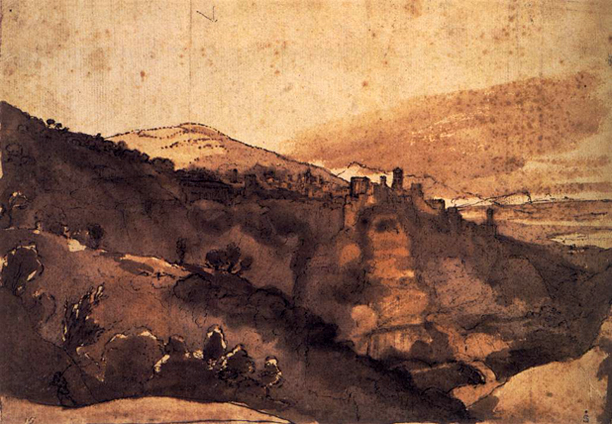

Life and works
Claude Lorrain, usually called simply Claude in English, was born of poor parents at Chamagne, a village in the then independent duchy of Lorraine. He received little schooling, and, according to his first biographer, Joachim von Sandrart, was brought up to be a pastry cook. His parents seem to have died when he was 12 years old, and, within the next few years, he travelled south to Rome.
In Rome he was trained as an artist by Agostino Tassi, a landscapist and the leading Italian painter of illusionistic architectural frescoes. At what stage and for how long he was apprenticed is uncertain, and, either before or during this period, Claude probably spent two years in Naples with Goffredo Wals, another pupil of Tassi. Tassi taught Claude the basic vocabulary of his art - landscapes and coast scenes with buildings and little figures - and gave him a lasting interest in perspective and, thus, in landscape painting.
In 1625, according to his second biographer, Filippo Baldinucci, Claude left Tassi and went back to Nancy, the capital of Lorraine, where he worked for a year as assistant to Claude Deruet on some frescoes (since destroyed) in the Carmelite church. But, in the winter of 1626-27, Claude returned to Rome and settled there permanently. He never married, but he had a daughter, Agnese (1653-ca. 1713), who lived in his house; also staying with him were a pupil, Giovanni Domenico Desiderii, from 1633 to ca. 1656, and two nephews, Jean from ca. 1663 and Joseph from ca. 1680. In 1633, to further his career, Claude joined the painters' Academy of Saint Luke.
Little is known of his personality. He took no part in public events and lived essentially for his work. In his early period he mixed with other artists, especially those who were of northern European origin like himself, but in his 40's he apparently became more solitary. He remained on good terms with the painter Nicolas Poussin, another French master of the ideal landscape, yet there was hardly any artistic contact between them. Although ill-educated in the formal sense (both his spelling and counting were eccentric, and he wrote haltingly in French and Italian), Claude was not the ignorant peasant of legend. The subjects of his paintings show that he had an adequate knowledge of the Bible, Ovid's Metamorphoses, and the Aeneid. He had a special feeling for the country, but his mode of life was that of a bourgeois. Industrious, amiable, and shrewd, surrounded by his modest household, and keenly sought after as an artist, he pursued a successful career into old age and amassed a comfortable fortune.
No work by Claude survives from before 1627, and he probably did not take up landscape until after that date. His first dated work is Landscape with Cattle and Peasants. Painted in 1629, it hangs in the Philadelphia Museum of Art. Soon after, in the early 1630's, he rose to fame. He did this partly on the basis of two or three series of landscape frescoes (all but one, a small frieze in the Crescenzi palace at Rome, are now lost), but, according to Baldinucci, he achieved renown chiefly because of his skill in representing those conditions of nature which produce views of the sun, particularly on seawater and over rivers at dawn and evening. By about 1637 - with commissions from Pope Urban VIII, several cardinals, and Philip IV of Spain - Claude had become the leading landscape painter in Italy.

In 1635-36 he began the Liber Veritatis (Book of Truth; in the British Museum, London), a remarkable volume containing 195 drawings carefully copied by Claude after his own paintings, with particulars noted on the backs of the drawings indicating the patron for whom, or the place for which, the picture was destined, and, in the second half of the book, the date. Although most paintings executed before 1635 and a few executed afterward are not included, the Liber Veritatis was compiled throughout in chronological order and thus forms an invaluable record of Claude's artistic development, as well as revealing his circle of patrons. Undertaken, as he told Baldinucci, as a safeguard against forgery of his paintings, the book gradually became Claude's most precious possession and a work of art in itself; he may also have used it as a stock of motifs for new compositions.
Claude's patrons were international and predominantly aristocratic, the majority being French or Italian noblemen. He was a fastidious worker and an expensive artist. He always worked on commission, at first sometimes selling his paintings through agents, but later he negotiated directly with patrons, with whom he would agree as to the size, price, and subject. Initially a fast painter, his rate of production subsequently slowed down. His late works are often individually larger and were still more carefully executed. About 250 paintings by Claude, out of a total of perhaps 300, and more than 1,000 drawings have survived. He also produced 44 etchings.
Stylistic development
Although they are basically consistent in method and aim, Claude's paintings show a gradual stylistic evolution, and it is possible to distinguish the phases of his development. His early works, showing the influence of Tassi and of Dutch and Flemish artists, are busy, animated, and picturesque. They are full of charm and effects of surprise. His smaller pictures, painted on copper, reflect the spirit of the German artist Adam Elsheimer, who had died in Rome in 1610. Occasionally Claude painted directly from nature during this period, although no examples have been certainly identified; his normal method of nature study was by means of drawings. A pattern common in the early paintings is a dark mass of foliage on one side in the foreground contrasted with a misty sunlit distance on the other. Herdsmen tending cattle or goats move out from beneath the trees or sit beside a stream (scarcely any of Claude's paintings at any time are without figures and animals).
Simultaneously Claude developed the traditional subject of a coastal scene with boats into a new type of picture: the seaport. This is an idealized harbor scene flanked on one or both sides with palaces, the latter often being adapted from actual ancient or contemporary buildings. Tall ships ride at anchor, recently arrived or preparing to depart. Light, however, is the key feature of the seaport pictures. Its source is often a visible sun just above the horizon, which Claude first introduced in 1634 in Harbor Scene and, in so doing, used the sun as the means of illuminating a whole picture for the first time in art. This use of light from the sky above the horizon, whether emanating directly from the sun or not, enforces another characteristic of Claude's paintings: recession in depth. Recession is further emphasized by subtle atmospheric perspective achieved through a gradual diminishing of the distinctness of outline and color from the foreground to the background. The light is nearly always that of dawn or evening.
Beginning around 1640 Claude began to make his compositions more classical and monumental. The influence of contemporary Bolognese landscape painting, particularly the works of Domenichino, replaces that of Tassi and the northerners. During this decade something like a formula establishes itself: tall trees on one side of the picture balanced by a classical ruin and smaller trees further back on the other; a foreground stage with figures; a winding river conducting the eye by stages through an open landscape to the horizon; and distant hills, often with a glimpse of the sea. The figures are not, as often before, in contemporary dress but are always represented in classical or biblical costume. Contrary to popular belief, virtually all of Claude's figures were painted by himself. Sometimes they are merely shepherds, but frequently they embody a subject from classical mythology or sacred history. The light is clearer than in paintings of the early or late periods. Spacious, tranquil compositions are drenched in an even light, as can be seen in Landscape: The Marriage of Isaac and Rebekah (also called The Mill), dated 1648.
The 1650's witness some still larger and more heroic paintings, including The Sermon on the Mount. In the middle of the following decade, Claude's style moved into its last phase, when some of his greatest masterpieces were produced. The color range is restricted, and the tones become cool and silvery. The figures are strangely elongated and by conventional standards ill drawn. At the same time, the subjects define the mood and sometimes determine the composition of the landscape. The paintings of this period are solemn and mysterious and radiate a sublime poetic feeling. It was in this spirit that Claude painted his famous work The Enchanted Castle.
Achievement as a Draftsman
Claude's drawings are as remarkable an achievement as his paintings. About half are studies from nature. Executed freely in chalk or pen and wash, they are much more spontaneous than his paintings or studio drawings and represent informal motifs - trees, ruins, waterfalls, parts of a riverbank, fields in sunlight - that Claude saw on his sketching expeditions in the Campagna. Many were executed in bound books, which have since been broken up. The studio drawings consist partly of preparatory designs for paintings - Claude prepared his work more carefully than any previous landscape artist - and partly of compositions created as ends in themselves.
Claude had only two students; nonetheless, his paintings influenced a number of Dutch painters who were in Rome during the late 1630's and '40's, and, in a broad sense, his influence can be seen even in the work of certain English landscape painters of the 19th century.
From: Web Gallery of Art
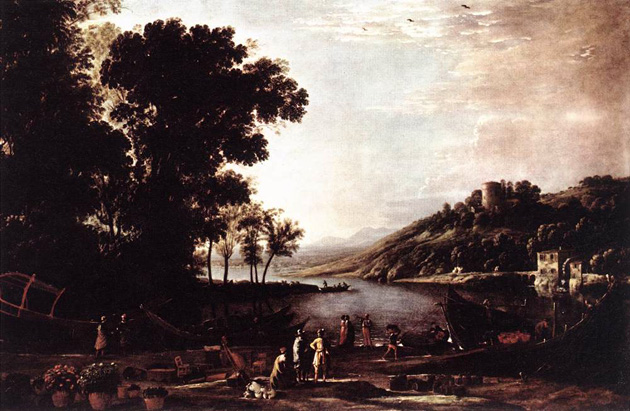
Claude's earliest surviving pictures have usually been dated to around 1630, although he did not begin to keep accurate records until the mid-1630's. By this time he was already mature, and so it is from the evidence supplied by the undated pictures that his first hesitant steps have to be reconstructed. The fact that he developed so rapidly from his first unpromising topographical scenes to become the virtual inventor of the atmospheric and poetical landscape is evidence of his genius. In the early pictures, considerable reference is made to a wide variety of painters, all of them landscapists. By about 1630 an enormous amount of landscape painting was going on in Rome, soon to be increased by the innovations of Poussin and Dughet. Claude therefore had to contend with many other artists working in mature styles, either influencing or ignoring one another. He drew almost casually from this varied background, now leaning on one, now on another, and then discarding them all, to achieve total self-confidence by the time he was thirty-five.

In The Mill there on the left is the regulation dark tree; the foreground is filled with incidents of the kind which Bril loved - boats in construction, fragments of ancient columns, and small figures, in this case artists sketching a boy milking a goat; on the right is a picturesque tower; behind it the trees form the next stage, and the hills close in the background. The Mannerist scheme is carried out even to the formula for the tree silhouettes.
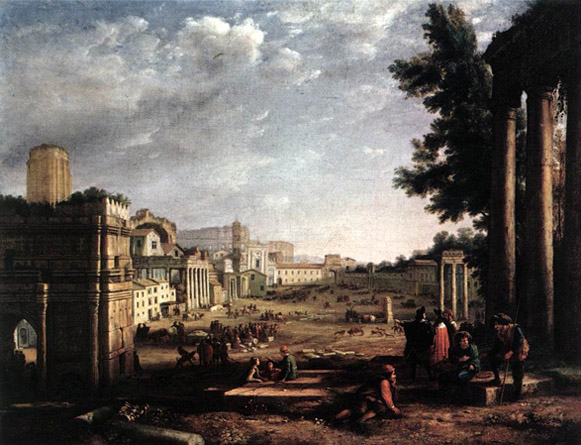
The painting is included in Liber Veritatis (LV 9).
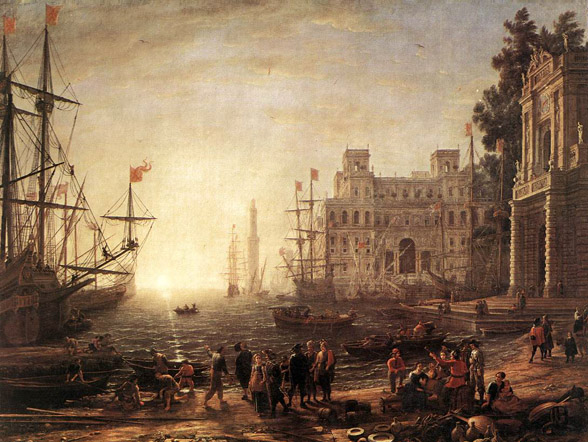
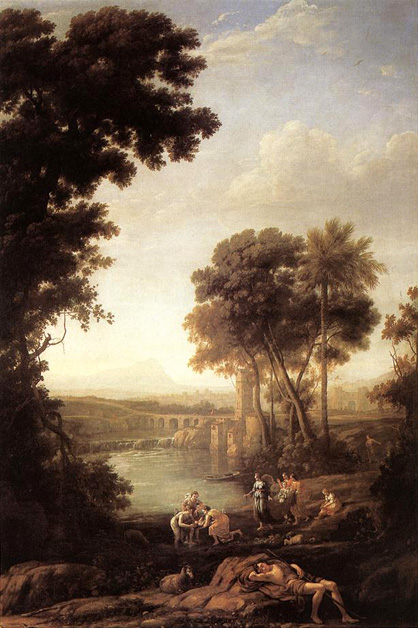
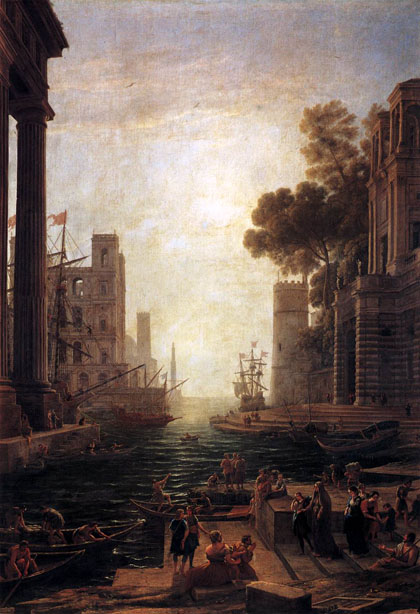
Claude Lorrain, sometimes also known simply as Claude, perfected the creation of ideal landscapes, placed in a golden classical antiquity of harmonious architecture, weather, landscape and society. This work so typical of his style was commissioned by Philip IV, King of Spain, for the decoration of one of the galleries in the Buen Retiro Palace. The act of embarkation is transformed by the theatrical setting into an act of Roman dignity, a heroic venture, a glorious example to posterity.
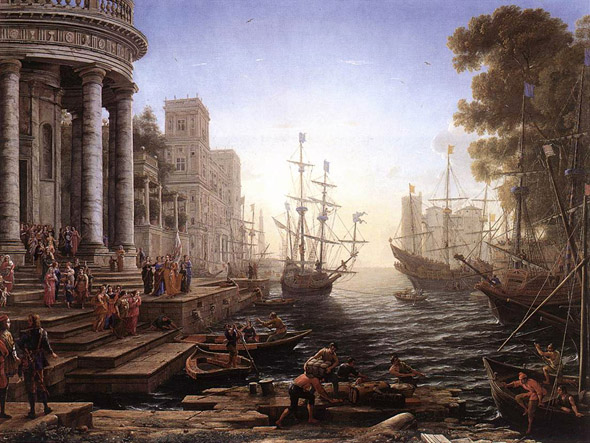
This picture is entirely concerned with the phenomenon of light; the golden tone fills the whole surface and envelops each of the individual elements. The actual subject, Saint Ursula embarking with her retinue of virgins, seems lost in this paean of praise for the sun, which shines directly at the spectator from the middle of the canvas. In this picture Claude perfectly observed an effect which eluded most painters before the nineteenth century - the convincing depiction of direct sunlight. Few of Claude's pictures go as far as this one, as he usually preferred to portray the softer light of early morning or late evening.
The painting is included in Liber Veritatis (LV 54).
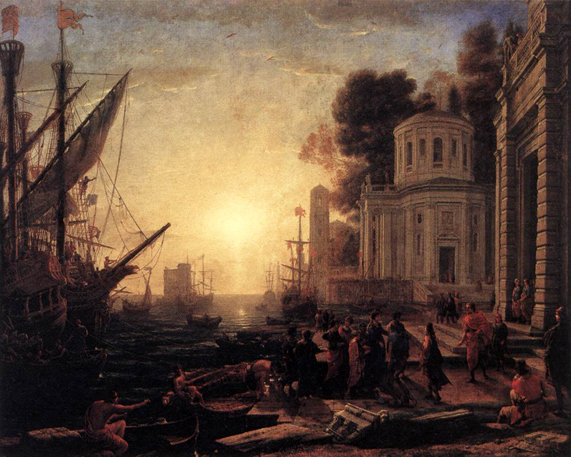
The Queen was not about to lose her status in Mediterranean politics because of the death of Caesar in 44 B.C.E. She had to come up with something else to give her substantial power. Following Caesar's death, Octavian, Caesar's adopted successor, Lepidus, and Antony had formed the Second Triumvirate. Antony had been proclaimed Triumvir of the East. In 37 B.C.E., Antony summoned Cleopatra to Tarsus to see if she had supported his enemies. Cleopatra, using her wit and charm, came to Tarsus in the midst of an impressive display of luxury and power. She was at the epicenter of the magnificent occasion, dressed as the divine Aphrodite. Antony was immediately impressed with what he saw and was smitten by the queen. He was seduced by Cleopatra.
Yet, both Cleopatra and Antony would meet a tragic end by their own hand.
Cleopatra was proud and ambitious. Her attempts to keep power exhibited her wit, cleverness, and strong will. The woman, who has gained immortality in art and literature, was also a woman nonetheless. She loved, lived, made mistakes, and eventually met a tragic end. Cleopatra still lives on in the human imagination today.

A shepherd-couple are placed in the foreground of this southern landscape. The woman is seated on a rock and is listening to the shepherd playing the shawm. To the right of the picture is a tent supported by a tree, and on the left a stone bridge leads to a ruined Roman temple. In the background the open sea is half-obscured by the mist of a warm summer's day.
Characteristic features of Claude's art are the subtle moods of the landscape and the variation in the seascape with the changing seasons. People are unimportant in his pictures; the painter regarded them only as a means of lending animation to his landscapes and as a rule he did not even paint them himself. In the 1630's he started a book which he gradually filled with pen-and-ink drawings of almost 200 of his own pictures; although it does not comprise his entire oeuvre, it is nevertheless a unique documentary record of his artistic creations. The book is preserved today in the British Museum under the title Liber Veritatis; and according to a note written on the verso, the work was commissioned by a patron in Paris.
This picture is recorded as having been in English private ownership in the early eighteenth century: until 1722 it was in the possession of the Duke of Portland, who sold it to the Earl of Scarbrough. About 1818 it passed into the possession of Count Pourtales and from him, in 1865, into the collection of the Marquis de la Ganay, from whom Bode bought it in 1881 for the Berlin Gallery.

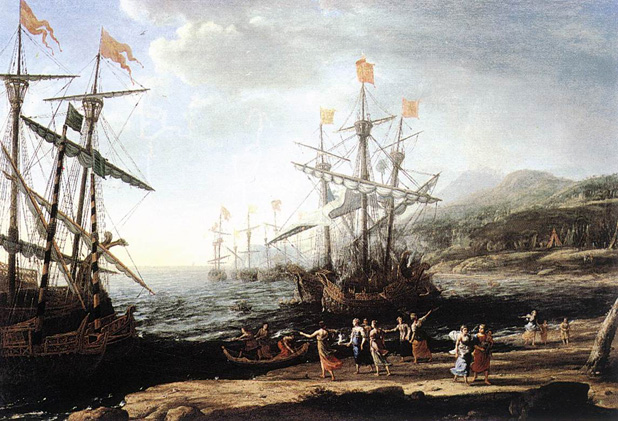
This painting is included in Liber Veritatis (LV 71).
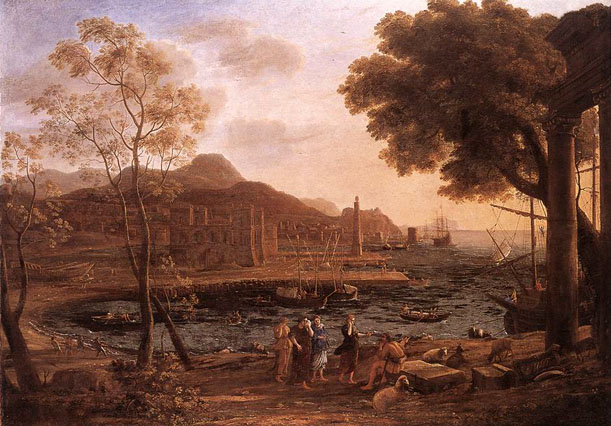
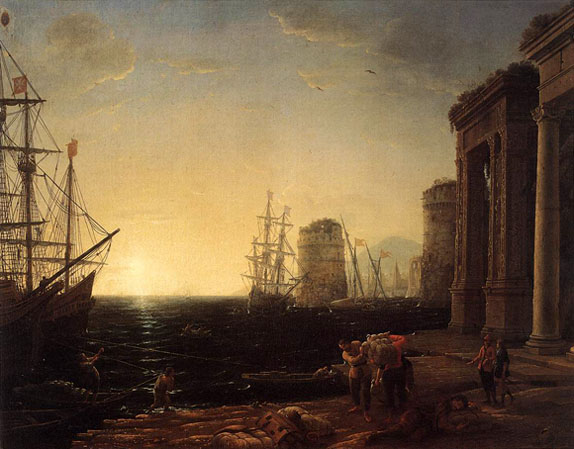
The connections - albeit inexact - between this Harbor Scene and LV 19 have resulted in the painting being dated to 1637, but cleaning in 1969 confirmed the authenticity of the date of 1643. Once this was established the stylistic distinctions evident between works of the 1630's and the 1640's could be confirmed. The deep ultramarine tone of the water, the overall warmth of color, and the more solid drawing of the figures, which, as a result, have a greater feeling of corporeality, are characteristic of the later decade. Comparison with the seaport scenes in the collections of the Duke of Northumberland and the Marquess of Bute, dating from 1637 and 1638 respectively, or with the rendering in Florence (Uffizi), also of 1638, reinforces these stylistic shifts. The picture in the Royal Collection was painted in the same year as Coast View with Mercury and Aglauros (Rome, Pallavicini collection) and Coast View with the Trojan Women setting Fire to their Fleet (New York, Metropolitan Museum). Three similar harbor scenes in the National Gallery, London, date from the 1640's and are comparable in style: Seaport with the Embarkation of Saint Ursula, Seaport of 1644, and Seaport with the Embarkation of the Queen of Sheba of 1648 - this last an inspiration to J. M. W. Turner.
Harbor scenes occur frequently throughout Claude's oeuvre. Usually depicted at sunset and populated by a full cast of staffage figures, busying themselves by loading and unloading ships or simply idling the day away in conversation, these compositions and the mood they created found favor with British collectors and were emulated by British artists. The only firmly identifiable building in the present picture is the monumental gateway on the right next to the round tower. This is based on the Arcus Argentarium (Arch of the Silversmiths), dating from the third century AD at San Giorgio in Velabro, Rome, although it is seen in reverse and detached from the church. A view of this arch and the church occurs in an early drawing by Claude at Windsor Castle.
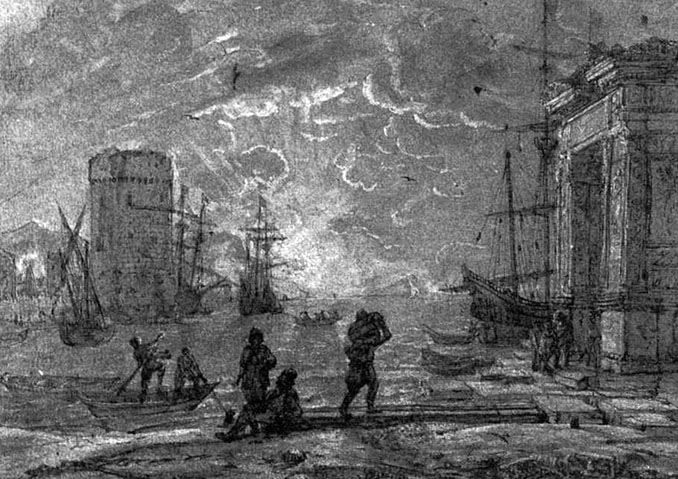
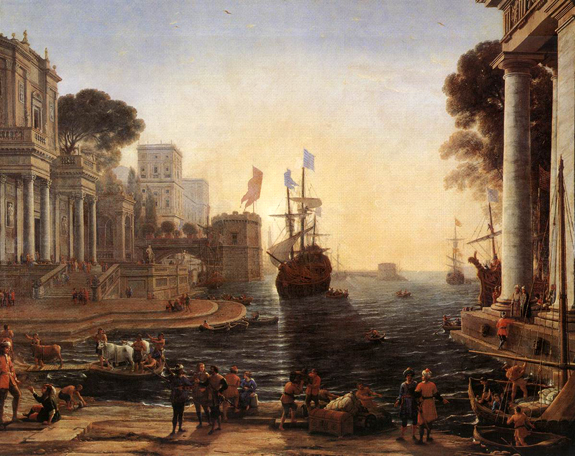
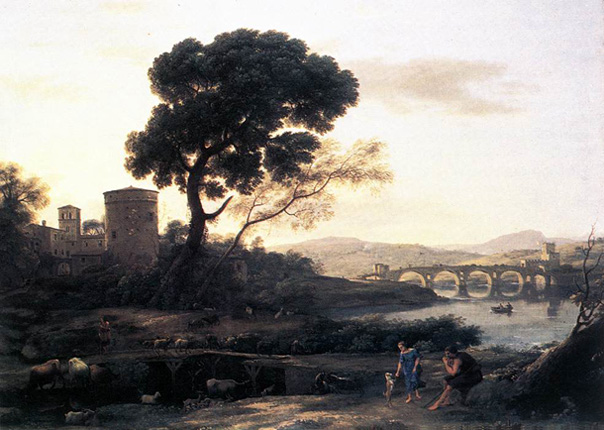
The best example of Claude's direct response to nature, although not topographically accurate, is the Landscape with Shepherds - the Ponte Molle of 1645 in the City Museum and Art Gallery, Birmingham. Each element in the picture is perfectly observed from nature; nothing is obviously artificial, but Claude arranged these elements - cabbage-like plants on the ground, classical ruins, a large pine tree - in a way which later generations came to regard as picturesque. To those unfamiliar with the actual landscape he painted, Claude's pictures seem even more artificial than they are. The Roman Campagna has changed little since the seventeenth century, especially the area around Tivoli; the terrain is dotted with the ruins of classical antiquity and there are numerous scattered pine trees which seem, especially when one is walking through them, to take on a `Claudian' aspect when juxtaposed with ruins. The light is marvelously clear, with the sky changing from blue to yellow in the morning and evening. Claude achieved a near perfect depiction of this atmosphere in the Birmingham picture : instead of the brilliant sunshine of the Saint Ursula there is a soft glow, in which the artist produces an almost milky light. He manages to capture atmosphere not by blurring the edges of each object depicted but by juxtaposing infinitesimal gradations of tone without losing the slightest detail. In all Claude's mature landscapes, and signally in this one, there is a sense of infinite distance in which the spectator can wander at will.
The painting is included in Liber Veritatis (LV 90).
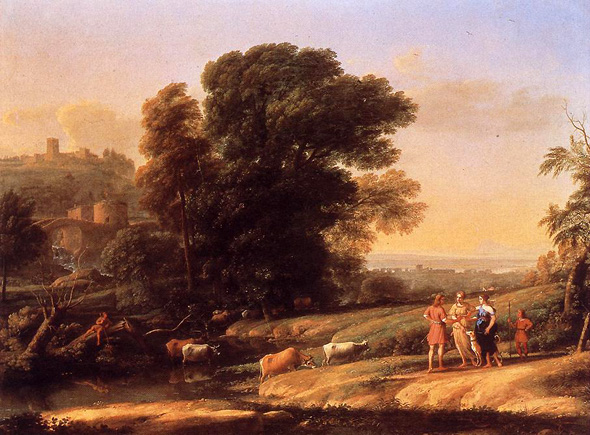
The painting is included in Liber Veritatis (LV 91).

The subject of this painting is taken from Greek mythology. Admetus was famed for his hospitality and justice. When Apollo was sentenced to a year of servitude to a mortal as punishment for killing the Cyclops, the god chose Admetus' home and became his herdsman. Apollo was so impressed by Admetus' treatment that the god made all the cows bear twins.
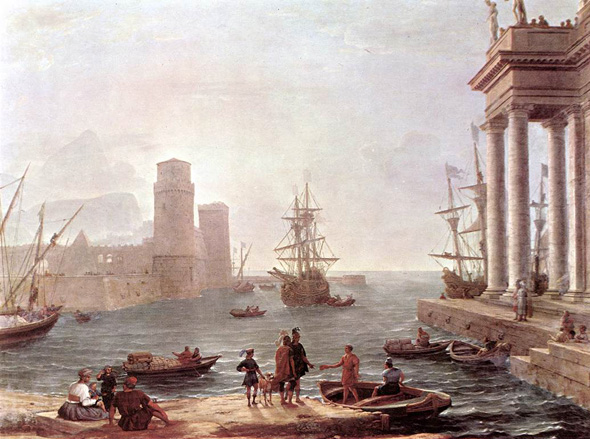
Perhaps the most beautiful of Claude's pictures are those in which he brings in the sea, whose effects he was able to study during the journey he made to Naples. The sea, for Claude, was a poetic element multiplying light; and he edged it with dream palaces, often motivating his pictures by scenes of embarkation or landing taken from history or religion.
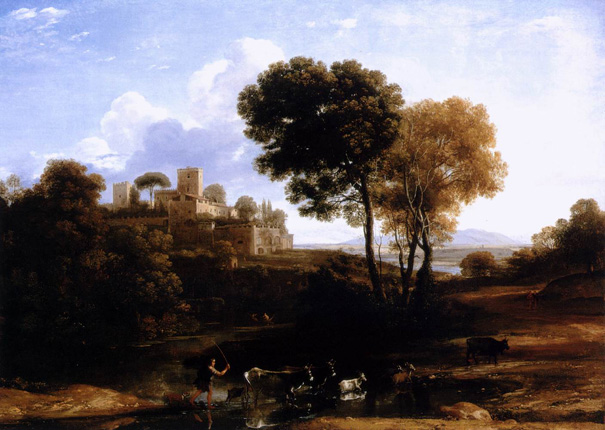
Like Nicolas Poussin, Claudee Gelle, a native of Lorraine, went to Italy while still young and lived and worked in Rome as an honored member of the artists' colony. Italian painters being on the whole not greatly attracted towards the painting of pure landscapes, the genre was first explored in the North and was introduced into Italy by painters from the Netherlands, Germany and France. The French painters, Poussin, Claude and Poussin's nephew, Gaspard Dughet, created a specific kind of landscape, known as the 'ideal landscape', introducing mythological or legendary figures and often creating a pleasing harmony by blending elements of reality with antique ruins or classical buildings. To all this Claude added a specific quality of his own - a magic evocation of mood, an exquisite shading of atmospheric elements and subtlety of lighting.
The painting in Budapest depicts a villa in the country near Rome, the house and the landscape bathed in the gentle light of the late afternoon sun; in the foreground, where the shadows have already lengthened, the surface of the water reflects the figures of the shepherd and his flock. The drawing for this picture is in the Duke of Devonshire's collection at Chatsworth; the inscription on the back of the drawing tells us that the picture was painted for Prince Pamphili, probably sometime in the 1640's.
The artist painted another version at about the same time; it is in the Hermitage in Saint Petersburg.
_1648.jpg)
Painted in 1648, these two pictures sum up Claude s mature art. He had arrived at this maturity by degrees, almost imperceptibly, refining and perfecting his technique. He had for many years been drawing from nature almost obsessively, and several hundred of his sensitive and often atmospheric drawings survive. He was therefore able to combine the more naturalistic approach seen in the Ponte Molle of 1645 with an increasing desire to turn the landscape into an idealized world. He had tried dramatic atmosphere in some of his early compositions, and had succeeded with direct sunlight but had not pursued it; but he developed in his later years the soft and subtle light effects which were the most difficult of all to achieve convincingly. As he grew older Claude became even more meticulous, and his pictures never acquired the looseness sometimes seen in the works of painters in their old age, even Poussin.
The painting is included in Liber Veritatis (LV 113).

A herd of cattle and goats approaches them to quench their thirst in the river. Everything unites to convey a vision of a harmonious world with a lively river, the font of life, flowing through its heart. Although the work is lent precision by the detailing of the different species of tree, it is the light that consolidates the whole: the clarity of the breaking day unfolding from the left - as always Claude has painted the early morning - brings the forms out of the shade and submerges the distance in a milky haze.
The painting is signed as "Clavde ivef" (ivef = invenit et fecit).

When Claude Gellee arrived as a boy in Rome from his native Lorraine, perhaps to serve as a pastry cook, landscape painting was already a recognized specialty. Claude, however, was to surpass all previous practitioners. His poetic reinventions of a Golden Age, appealing to a cultivated aristocratic clientele, were assembled in the studio from drawings made out of doors in Rome and the surrounding countryside and in the Bay of Naples. The German painter Sandrart, who accompanied him on sketching trips, described his procedures:
(Claude)...only painted, on a small scale, the view from the middle to the greatest distance, fading away towards the horizon and the sky... (he is an example to all) of how one can order a landscape with clarity, observe the horizon and make everything diminish towards it, hold the coloring in proportion with the depth, each time represent recognizably the time of day or the hour, bring everything together in correct harmony by accentuating strongly the front and shading off the back in proportion...
Claude's influence indeed became all-pervasive, most of all in eighteenth-century England, where it affected not only painting and collecting but the very ways in which real landscape was viewed and artificial parkland constructed.
Like many of Claude's pictures, the Seaport with the Embarkation of the Queen of Sheba was conceived as one of a pair; its companion, the Landscape with the Marriage of Isaac and Rebekah ('The Mill'), is also at the National Gallery. They were commissioned by Camillo Pamphili, nephew of Pope Innocent X. Before the exceptionally large canvases had been completed, Pamphili renounced his cardinal's hat to marry and was expelled from Rome in disgrace; the paintings were finished for the Duc de Bouillon, French general of the papal armies. Both relate (through inscriptions, our only clues to their subjects) to stories from the Old Testament - thought at the time to be especially suitable for the pictorial decoration of cardinals' palaces - on the theme of love, or esteem, between men and women, and recounting fateful journeys. While most contemporary churchmen would have interpreted the tales as symbolic of Christ's union with the Church, Pamphili may have wished to refer covertly to his own love for Olimpia Aldobrandini.
Claude follows his usual method of simultaneously harmonizing and contrasting the two pictures: the Marriage of Isaac and Rebekah is a landscape in late summer afternoon, the Embarkation a coastal view, depicted in early morning light like all of Claude's Embarkations. The Queen of Sheba's land journey 'with camels...and very much gold' to visit King Solomon (1 Kings 10:1-2) is transformed into the viewer's own imaginary voyage, leaving harbor to sail on the open sea towards the light. (The queen, a small figure in red, descends the stairs to be rowed out to her vessel moored on the horizon.)
Including the sun within a painting was Claude's greatest early innovation. Exactly half-way up the canvas in this stateliest of his seaport compositions, it is the basis of its pictorial unity, all the colors and tones adjusted in relation to it Claude's palm and finger prints can be seen in many places in the sky where he smoothed transitions from one passage to the next. The boy sprawling on the quay-side shields his eyes from its dazzle, and its rays gild the rounded edges of the fluted column and Corinthian capital beside him.
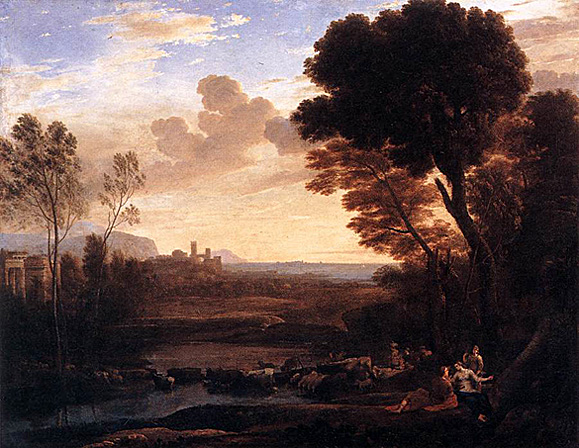
The painting, also called The Ford, is a pendant to Ulysses Returns Chryseis her Father.

The painting, also called The Ford, is a pendant to Ulysses Returns Chryseis her Father.
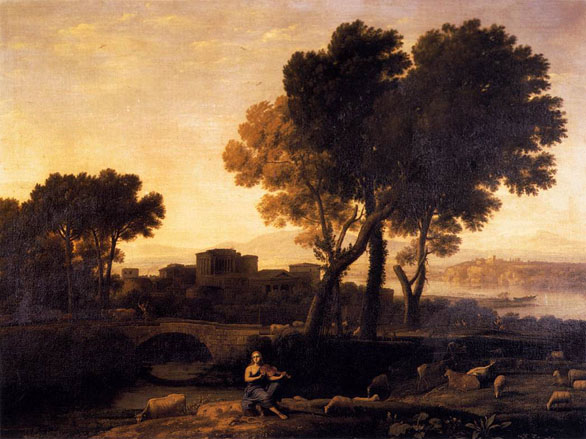
This composition consists of two masses of trees and an Etruscan town all rising like blocks from a composition primarily planned on the horizontal plane.
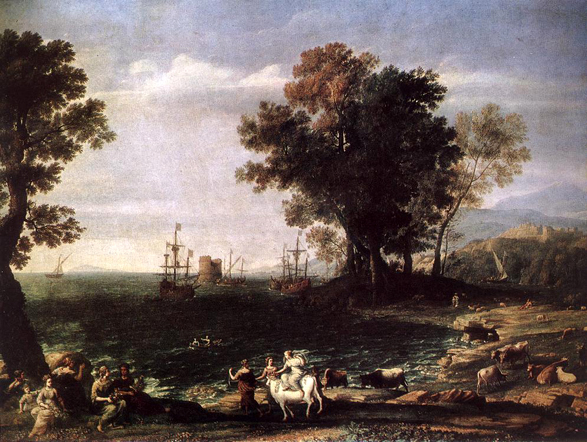
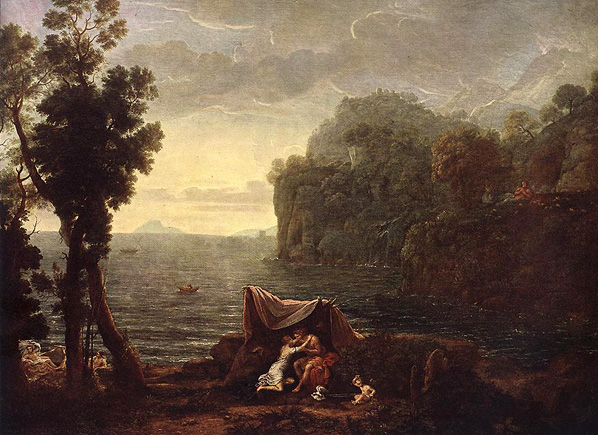
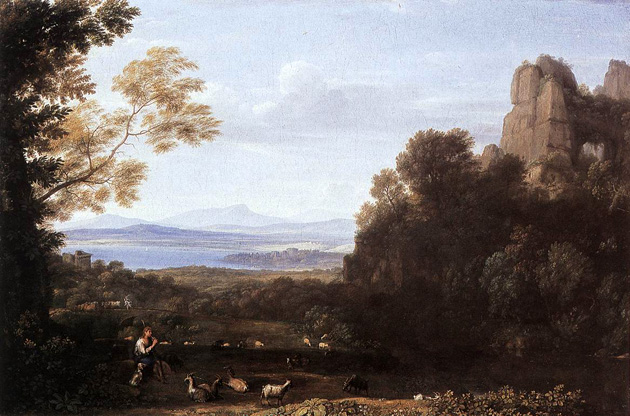
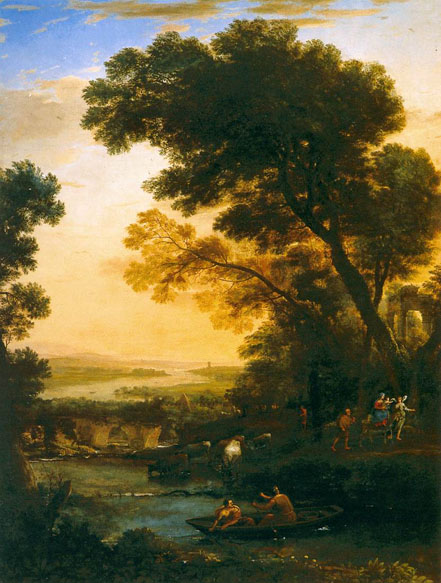
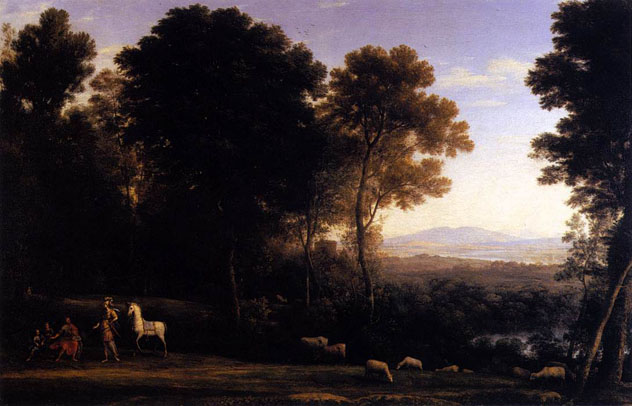
In his paintings Claude creates a loose space, almost always leading the eye to infinity at some point, and often with a wide line of horizon. This space is filled with atmosphere which penetrates the trees standing in it and forms the continuum of the picture. Recession is established often without the use of linear perspective, by the subtle degradation of color, usually in objects such as trees which have no sharp outline. Moreover, these objects may be disposed on a horizontal plane, as are, for instance, the trees covering the valley in the Erminia, in which the eye is led from the river to the extreme distance simply by the change in color of the groves.
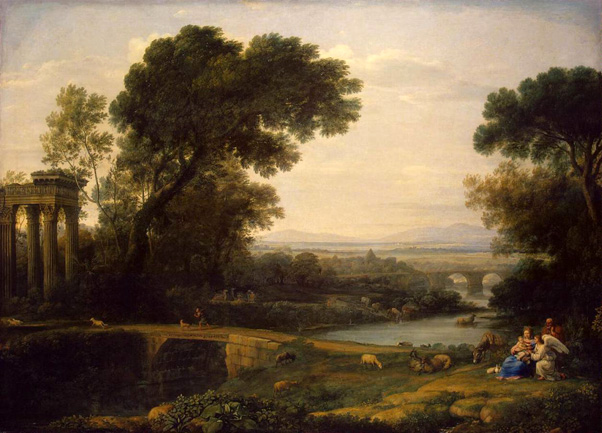
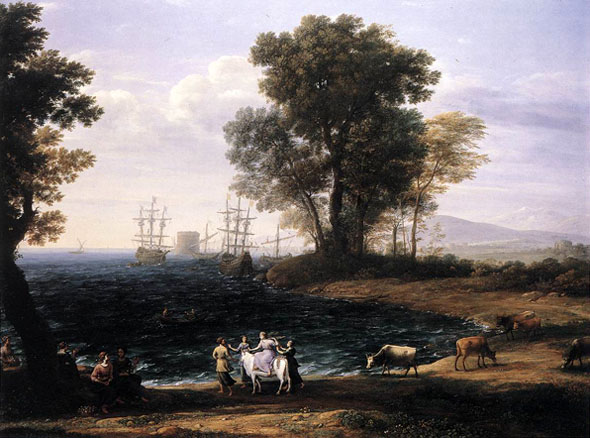
There are in all five painted versions of this subject by Claude dating from four different decades. The earliest is dated 1634 (Fort Worth, Kimbell Art Museum), followed by the second, dated 1647 (on loan to Utrecht, Centraal Museum), a third dated 1655 (Moscow, Pushkin Museum) and a fourth of 1658 (private collection). The version in the Royal Collection, dated 1667, is the last in the series and in many ways marks the climax of the artist's treatment of the theme. This is admirably reflected in its heightened poetic sensibility and the sophisticated level of technical skills. Of the various compositions, that of 1634 is also recorded in an etching, while the others are included in Claude's Liber Veritatis (LV 111, 136 and 144), which served as an official drawn record made by the artist himself of his painted compositions dating from 1637 onwards.
While the basic features of the design and iconography were established in the Fort Worth painting, changes or differences in emphasis occur in the others as Claude modified his style. It is also true to say that the version in Utrecht served as the basis for the later renderings, particularly in the greater spaciousness of the setting. There is a closer compositional affinity, however, between the painting in Moscow and the present picture, although small alterations in scale and in the number of figures and animals are apparent. For the painting in the Royal Collection Claude most probably referred back to the drawing of the Moscow version made for the Liber Veritatis (LV 136), although the picture itself remained in Rome in the collection of Fabio Chigi (1599-1667), who was elected Pope as Alexander VII in 1655 and was one of the artist's most important patrons.
There is circumstantial evidence in the form of an inscription made by a later hand on the back of the drawing (LV 136) that the painting in the Royal Collection was made for Philippe de Graveron. An autograph drawing dated 1670, not from the Liber Veritatis, after the present painting is in the British Museum, London.
The source for the story of the 'Rape of Europa' is Ovid's Metamorphoses (II, 833-75). Jupiter, enamored with Europa, the daughter of Agenor, changes himself into a white bull and mingles with the herd of cattle on the seashore where Europa and her maidens linger. Attracted by the beauty of the bull and not aware of Jupiter's transformation, Europa climbs onto its back and is abducted, eventually being carried out to sea. The description in Ovid is immensely poetic and Claude, by this time well versed in mythology and fully practiced in its depiction, successfully expresses the beauty of the text in paint. The mood of the picture is established principally by the chief compositional features of trees, coastline, vessels and fortification judiciously placed within the picture space. The wide spatial intervals create a feeling of calm while quicker rhythms required for the narrative are concentrated in the foreground. The tonal values help to create an atmosphere charged with poetic feeling while the soft breeze wafting from the water is almost palpable. The overall beauty of the painting is enhanced by a number of felicitous details, both in terms of color and of observation, in which Claude's painting matches Ovid's poetry. The care lavished on the draperies, the flowers and garlands, the waves lapping the sides of the vessels, and the down along the flanks of the cattle testify to the precision of Claude's art in creating a world that oscillates between quotidian experience and Arcadian bliss.
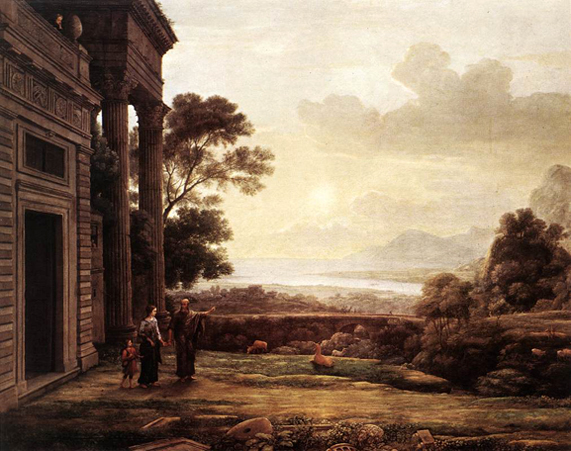
The biblical story depicted in the paintings is the following.
Hagar, the Egyptian hand maiden of Sarah was the mother of Ishmael, Abraham's first son. When Isaac, Sarah's son, was born Ishmael mocked his younger brother so that Sarah asked Abraham to banish him, together with his mother. Abraham provided them with bread and a bottle of water and sent them of into the desert of Beersheba. When the water was spent Hagar put Ishmael under a bush to die and then sat some way off, weeping. But an angel appeared, by tradition the archangel Michael, and disclosed a well of water nearby, so they were both saved. Two scenes, the banishment, and the appearance of the angel are common in 17th century Italian and Dutch painting.
The painting is included in Liber Veritatis (LV 173). The pendant of the painting, Hagar and Ishmael in the Desert (LV 174), is also in the Alte Pinakothek.


In the last ten years of his life Claude painted six stories of Aeneas, hero of Virgil's Aeneid - the Latin epic describing the legendary origins of Rome. The theme seems to have been suggested by Claude himself. He chose scenes which had never been illustrated before; they do not form a series, nor were they painted in the order in which they appear in the Aeneid. As if echoing Virgil's 'I am that man who in times past tuned my song on the slender reed (of pastoral poetry)', the painter turned, at the age of 68, to sing the voyages of the survivor 'fated to be an exile...the first to sail from the land of Troy and reach Italy'. These six Aeneas pictures, of which Aeneas at Delos is the first, represent Claude's most personal achievement, attaining a nobility of style visually equivalent to the grandeur of Virgil's poem.
Throughout the 1640's and 1650's Claude had often illustrated Ovid's Metamorphoses, and it may be through the Metamorphoses that his interest in Aeneas' adventures was first aroused. In Book XIII Ovid relates the hero's flight from burning Troy; Claude's painting is based more closely on this passage than on Virgil's description in Book III of the Aeneid. Ovid tells how - taking with him sacred images of the gods, his father Anchises (the bearded man in blue) and his son Ascanius (the child on the right) Aeneas (in short red cloak):
"set sail...and...reached with his friends the city of Apollo (Delos). Anius (in white on the left), who ruled over men as king and served the sun god as his priest, received him in the temple and his home. He showed his city, the new-erected shrines and the two sacred trees (olive and palm) to which Latona had once clung when she gave birth to her children (Diana and Apollo)."
The stone relief atop the portico in the foreground represents Diana and Apollo slaying the giant Tityus, who tried to ravish their mother.
This is one of the most evocative pictures ever painted. The figures, elongated perhaps in the belief that the ancients were taller than we, are dwarfed by the sacred trees and the majestic buildings. Apollo's round temple recreates the original appearance of the Pantheon, reminding us of the Delian oracle's prophecy of Rome's future splendor. Meditation on time is at the very heart of the painting. A dual longing, for both the Trojan past and Aeneas' future as founder of Rome, is embedded in the perspective construction. The projecting lines of the architecture meet at the level of the horizon to the left of the canvas, while the lines of the road converge to the right.


Unlike Poussin, who tried to imitate his source in as accurate a manner as possible, Claude used the poetry as a source of general inspiration for his pictures, which remained landscapes first and foremost. Virgil's pastoral poetry, the Eclogues and the Georgics, had already been used by Claude in a generalized way for his many scenes of shepherds resting, dancing or simply minding their flocks in an ideal landscape. The almost wistful verse of Virgil could be translated into paint by Claude without any pedantic references to specific passages, and without arousing any argument over the precise passage illustrated.
The story depicted in the painting is from Virgil's Aeneid (4:362-392). The lovers, Dido and Aeneas, passed a whole winter in each other's company, until Aeneas was suddenly visited by Mercury, the messenger of the gods, with sharp orders from Jupiter to be on his way. He took his leave amid scenes of passionate pleading, vituperation and tears. When Aeneas had departed Dido built a funeral pyre in the palace and slew herself on it, using her lovers sword.
The painting is included in Liber Veritatis (LV 186).
_1680.jpg)
The mythological story depicted on the picture is the following.
Apollo, as the God of Poetry and Music (in this role named Apollo Musagetes), dwells on Mount Parnassus, accompanied by the muses, the goddesses of poetic inspiration and the creative arts in general. The running brook is the Castilian spring, which, like another, the Pierian, was a source of inspiration and learning where we are advised to drink deep.
The painting was executed for the Principe Colonna, and was in the family collection until at least 1783.
It is included in Liber Veritatis (LV 193).
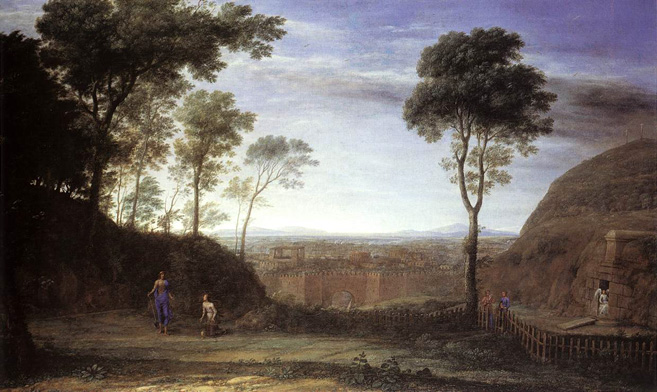
This is a late work of the artist. He placed the Noli me tangere scene (the meeting of Christ and Mary Magdalene after the Resurrection) into a wide landscape depicting Jerusalem in the background and the Golgotha at the right.
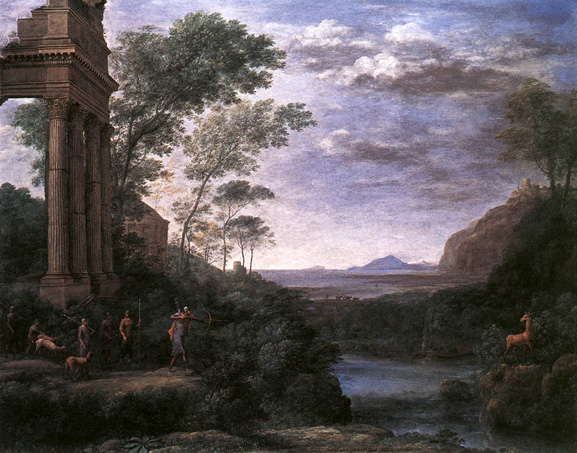
In the painting the yellows have faded completely, leaving a bluish tinge over the whole and the entire surface has been abraded. As a result the picture has an unnatural and ghostly feeling. The composition is one of Claude's most calculated, with trees, distant landscape and figures in total harmony. The Deruet-like figures are more prominent than usual, with their bright blues and reds. The story is a tragic one: Ascanius accidentally shoots the stag of Sylvia, which unleashes a brutal war of revenge. It is fitting that Claude should have ended his career on this theme without depicting brutality, as it sums up his gentleness of temperament as an artist.
The painting was executed for the Principe Colonna and was still in the collection in 1783.
Source: Web Gallery of Art
Source: Art Renewal Center
Return to Pagina Artis
Return to Bruce and Bobbie's Main Page.